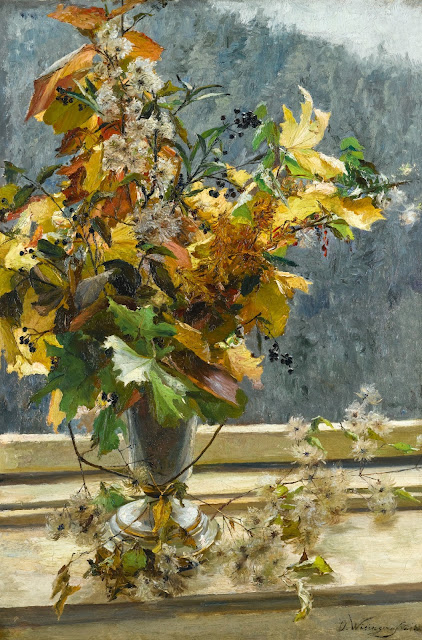Olga Wisinger-Florian ( Austrian,1844-1926 )
HERBSTLAUB (AUTUMN LEAVES)
oil on canvas;77 by 52cm

"In the present work the vivid luminosity reflected by the foliage in the autumnal bouquet is particularly stunning, and perfectly offset by the more muted background visible through the window beyond. The thick, energetic brushstrokes and brilliant palette capture the beauty of the foliage, punctuated by the clematis seedheads and wild berries." Sotheby's
EIN WILDBLUMENSTRAUSS (A SPRAY OF WILD FLOWERS)
oil on panel ; (16.5 x 26 cm.)
Christie's

Stiefmütterchen und Schmetterlinge,1926
Öl auf Holz, 28 x 37 cm
Dorotheum

STILL LEBEN MIT STIEFMÜTTERCHEN (STILL LIFE WITH PANSIES)

***
Together with Tina Blau and Marie Egner Olga Wisinger-Florian was one of the most successful female Viennese painters of the late 19th century. Having initially trained as a concert pianist, a hand injury prompted her - aged 30 - to explore painting as an alternative career in the mid-1870s. After taking private lessons from the landscape painter Melchior Fritsch and studying for three years under August Schaeffer at the Vienna academy, she became a private pupil of Emil Jakob Schindler in 1880. Together with her teachers and co-disciples Marie Egner and Carl Moll, Olga Wisinger-Florian went on study trips to Lundenburg and Goisern, and later to Dalmatia and Montenegro, Italy and Paris. From 1881 she regularly showed paintings at the annual exhibitions mounted at the Vienna Künstlerhaus and later also at the Viennese Secession exhibitions. Work she showed at the Paris and Chicago international exhibitions in the 1890s earned her worldwide acclaim.
Wisinger-Florian's early paintings can be assigned to what is known as Austrian mood Impressionism (Stimmungs-Impressionismus). In her early landscape paintings she adopted Schindler's approach to nature. Her motifs from this period, flowering fields and meadows, tree-lined avenues and gardens in full bloom were strongly reminiscent of her teacher's work. After breaking with Schindler in 1885, however, Olga Wisinger-Florian went her own way, and her depictions of landscapes became more realistic. Her late work is notable for its progressive, vivid, expressionist palette that was very much ahead of its time.
In the late 1880s Wisinger-Florian started specialising in flower still lifes. Her depictions of flower bouquets before a naturalistic backdrop and flower studies within landscapes from this period count among her best paintings.
In the present work the vivid luminosity reflected by the foliage in the autumnal bouquet is particularly stunning, and perfectly offset by the more muted background visible through the window beyond. The thick, energetic brushstrokes and brilliant palette capture the beauty of the foliage, punctuated by the clematis seedheads and wild berries.
http://www.sothebys.com/en/auctions/ecatalogue/2013/european-paintings-l13101/lot.213.html
***
Marie Egner (Austrian, 1850-1940)
http://elle-belle10.livejournal.com/1914998.html
This entry was originally posted at http://elle-belle.dreamwidth.org/1797012.html. Please comment there using OpenID.
oil on canvas;77 by 52cm

"In the present work the vivid luminosity reflected by the foliage in the autumnal bouquet is particularly stunning, and perfectly offset by the more muted background visible through the window beyond. The thick, energetic brushstrokes and brilliant palette capture the beauty of the foliage, punctuated by the clematis seedheads and wild berries." Sotheby's
EIN WILDBLUMENSTRAUSS (A SPRAY OF WILD FLOWERS)
oil on panel ; (16.5 x 26 cm.)
Christie's

Stiefmütterchen und Schmetterlinge,1926
Öl auf Holz, 28 x 37 cm
Dorotheum

STILL LEBEN MIT STIEFMÜTTERCHEN (STILL LIFE WITH PANSIES)

***
Together with Tina Blau and Marie Egner Olga Wisinger-Florian was one of the most successful female Viennese painters of the late 19th century. Having initially trained as a concert pianist, a hand injury prompted her - aged 30 - to explore painting as an alternative career in the mid-1870s. After taking private lessons from the landscape painter Melchior Fritsch and studying for three years under August Schaeffer at the Vienna academy, she became a private pupil of Emil Jakob Schindler in 1880. Together with her teachers and co-disciples Marie Egner and Carl Moll, Olga Wisinger-Florian went on study trips to Lundenburg and Goisern, and later to Dalmatia and Montenegro, Italy and Paris. From 1881 she regularly showed paintings at the annual exhibitions mounted at the Vienna Künstlerhaus and later also at the Viennese Secession exhibitions. Work she showed at the Paris and Chicago international exhibitions in the 1890s earned her worldwide acclaim.
Wisinger-Florian's early paintings can be assigned to what is known as Austrian mood Impressionism (Stimmungs-Impressionismus). In her early landscape paintings she adopted Schindler's approach to nature. Her motifs from this period, flowering fields and meadows, tree-lined avenues and gardens in full bloom were strongly reminiscent of her teacher's work. After breaking with Schindler in 1885, however, Olga Wisinger-Florian went her own way, and her depictions of landscapes became more realistic. Her late work is notable for its progressive, vivid, expressionist palette that was very much ahead of its time.
In the late 1880s Wisinger-Florian started specialising in flower still lifes. Her depictions of flower bouquets before a naturalistic backdrop and flower studies within landscapes from this period count among her best paintings.
In the present work the vivid luminosity reflected by the foliage in the autumnal bouquet is particularly stunning, and perfectly offset by the more muted background visible through the window beyond. The thick, energetic brushstrokes and brilliant palette capture the beauty of the foliage, punctuated by the clematis seedheads and wild berries.
http://www.sothebys.com/en/auctions/ecatalogue/2013/european-paintings-l13101/lot.213.html
***
Marie Egner (Austrian, 1850-1940)
http://elle-belle10.livejournal.com/1914998.html
This entry was originally posted at http://elle-belle.dreamwidth.org/1797012.html. Please comment there using OpenID.